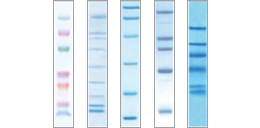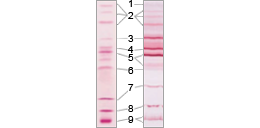Bio-Rad offers a wide array of protein ladders to cover all your needs both in terms of size range and chemistry.
Protein Ladder Product Types
Originally molecular weight markers were a mixture of easy-to-purify proteins of known molecular weight. These marker proteins were unstained, and were generally visualized on SDS-PAGE gels by staining the gel with Coomassie Brilliant Blue R250, or after western transfer by a stain such as Ponceau S. Now there are a myriad of options.
Natural vs. Recombinant Proteins: There is variability for prestained naturally occurring proteins, in the amount and location of dye that binds to each protein. Prestained natural proteins may produce broader bands than recombinant proteins, particularly when the proteins are prestained with more than one color. The broad, less distinct, bands make them less attractive for molecular weight estimation. Though there are many laboratories that continue to use natural protein ladders, most now use recombinant standards.
The recombinant proteins used in protein ladders have been engineered to have tight bands, as well as specific traits such as evenly spaced molecular weights, individual proteins stained with different colors for easy identification, or affinity tags for detection on western blots.
Molecular Weight Range: Natural protein standards come in high molecular weight range, low molecular weight range, and broad molecular weight range. Unstained natural protein standards also come in a polypeptide range (1.4–26.6 kD). Every recombinant protein ladder is broad range.
Prestains and Tags: Proteins within a ladder may be stained all one color, have two or more bands stained different colors to make sure that the molecular weights within the ladder are easily identified, or have a multicolored pattern like Kaleidoscope™ protein standards.
An advantage of using a prestained protein ladder is that the migration of the size range of the polypeptides of interest can be monitored during electrophoresis. With an unstained protein ladder, only the bromophenol blue at the dye front is used to monitor the progress of the gel and blotting efficiency is not readily determined. All prestained recombinant ladders include three high-intensity reference bands (25, 50, and 75 kD).
For size determination on western blots, depending on the visualization method being used, the protein ladder can be unstained, prestained, or with a Strep-tag sequence. High-affinity binding of StrepTactin, a genetically modified form of streptavidin, gives convenient and simultaneous detection of both proteins and standards on western blots using either colorimetric or chemiluminescence methods. StrepTactin-HRP and StrepTactin-AP are available.
Fluorescent properties: Many of the stained recombinant proteins are excited by wavelengths used in fluorescent detection systems. See the product overview pages for specific details.
Both fluorescently labeled proteins and chemiluminescence can be detected and analyzed with instruments such as the ChemiDoc™ or Gel Doc™ imaging systems.
IEF (Isoelectric focusing) and 2-D SDS PAGE Ladders: In IEF, proteins migrate through an immobilized pH gradient until they get to their isoelectric point (pI) where they have no charge and cease migrating. This is often followed by SDS-PAGE in the second dimension (2-D SDS-PAGE). An IEF protein ladder contains native proteins with a range of isoelectric points. Molecular weight (within limits) is irrelevant. For 2-D SDS PAGE, the protein ladder must contain proteins that both span an appropriate pI range and, when reduced and SDS-denatured, cover a suitable molecular weight range.
Bio-Rad IEF standards are natural proteins with isoelectric points ranging from 4.45 to 9.6. The 2-D SDS-PAGE standards have a pI range from 4.5 to 8.5 and a molecular weight range from 17.5 to 76 kD.
Protein Ladder Selection
Bio-Rad protein ladders have been formulated and combined for use as molecular weight markers in a variety of applications including SDS-PAGE, IEF, 2-D PAGE, and western blotting.
For SDS-PAGE, choose from prestained and unstained, natural or recombinant protein ladders for broad, high, and low molecular weight ranges. Ladders for IEF and 2-D SDS-PAGE provide reproducible calibration for pI estimation. For western blotting, use any of the SDS-PAGE ladders or those optimized for chemiluminescence detection. Whatever your needs for protein electrophoresis and western blotting, there is at least one protein ladder that meets all your requirements.
Related Topics
Agarose, Biotechnology Equipment, Chromatography Systems, Luminex, SYBR® Green Master Mix, Thermocycler



